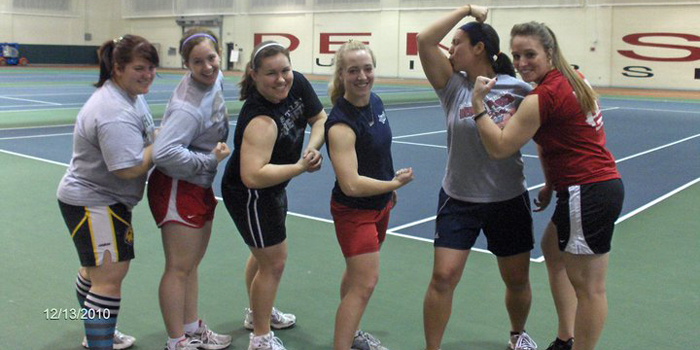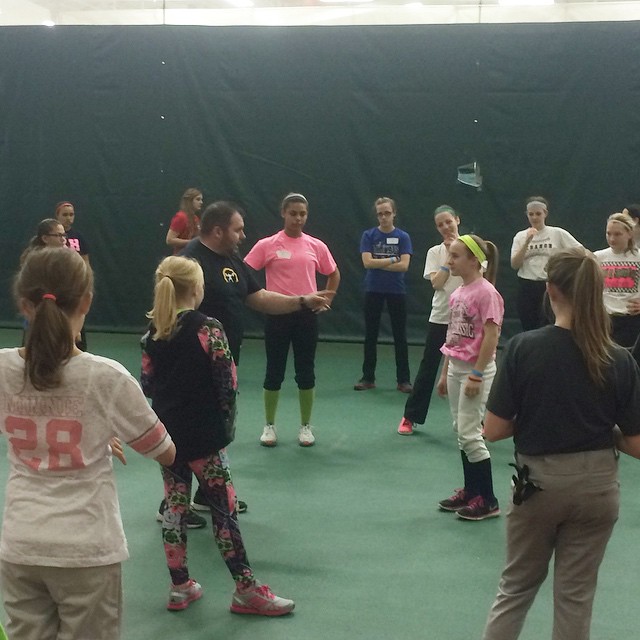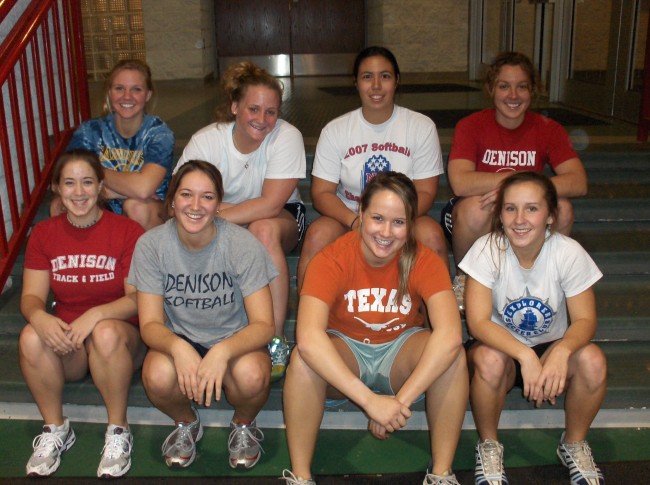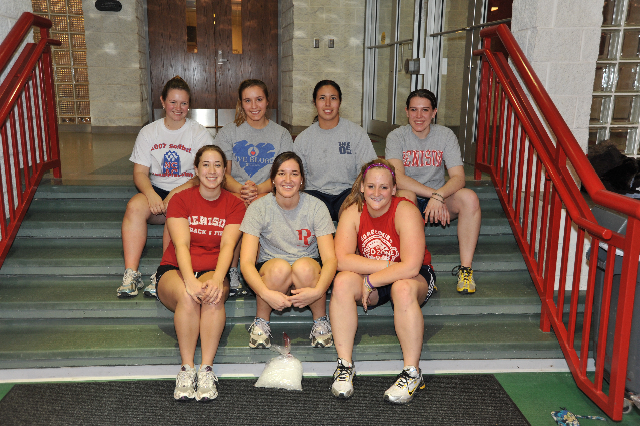
On the heels of a Women's World Cup Championship and Ronda Rousey defending her UFC Bantamweight title in devastating fashion, female athletes are gaining the much deserved respect they should have always received. Perhaps it is the extended media coverage, more opportunities for women, or better grassroots programs for young girls; regardless it has provided some much need role models. Let's just try at all costs to avoid all conversations of who would win in a fight... Ronda or a dude.
Do you train female athletes different from males?
The answer:
I don't train them differently
But, it's not that simple. Overall the programming is the same. Periodization schemes, sets, reps, volume, load, rest intervals, etc. are all very similar between genders. I will admit, some of this is due to logistical simplicity when training multiple sports.
There are some things to think about when training female teams that range from coaching cues to culture. This could be an e-book in itself, so I will summarize as much as possible.
The main argument for making any changes in training males versus females has more to do with the discrepancies between training age and chronological ages. For college age athletes, biological age is not as big of a factor. On average training age for males is usually higher than a female of the same chronological age.
Why? In my opinion, this is due to social constructs, the media, poor coaching, and not enough education for parents and coaches. There are societal barriers that have kept a negative stigma or young girls being or training to be strong. That's another topic all together. So, here are some general points:
Considerations for Female Athletes
This could be an article in itself, but to be honest, there are really not as many as you think.
- Band Progressions for Pull-Ups along with the implementation of Diesel rows for a vertical pull variation.
- Obvious Adjustments with accommodating resistance. These are mostly based on strength levels regardless of gender, but the starting point is light bands for squats and micro-minis with bench.
- Upper Body plyometrics will be elevated or band resisted unless engaging in deceleration type push-up sequences.
This was included in a Softball training program article I wrote back in the Spring. Click on the Link below to read the article.
Why Softball Players are Tougher than Baseball Players
Pre-Habilitation
ACL prevention is a huge endeavor for female athletes. Not to say the prevention strategies shouldn't be the same for both genders, but females are 2-8 times more likely due to both internal and external factors. Everything from a more pronounced Q-Angle, ligament notch width, ligament size and laxity, hormonal issues, neuromuscular control, quad to hamstring ratio, etc can have an affect. I am not an ATC or PT, but we had some very basic protocols:
1.) Nuero-muscular control (landing mechanics)
2.) Posterior chain development (Glute Ham Raises)
3.) Hip Abduction (Anti valgus/ anti-internal rotation)
Interview with Dr. Tim Hewett on ACL Injury Prevention
Female athletes are at more risk than just ACL injuries. Long Distance running leading to shin splits and poor balance in the Posterior shoulder girdles can also be points to address in programming. Most of these potential risks are similar between males and females so it make more sense to address the issues based on individual needs.
Bodyweight Training
This is both a challenge and a motivating factor for training women. Because of the relative body strength of women, it is more challenging to program certain exercises such as pull-ups and chin-ups. That is why bands were always so important for our chin-up progressions.
Often times female athletes are either intimidated or unmotivated to used heavier weights than prescribed. With bodyweight type exercises, the option of using a lighter weight is no longer available.
Here are a few bodyweight protocols we would incorporate:
Rep Goals
The goal is to give the athlete a total rep goal for an exercise. For example, with 25 glute-ham raises prescribed, athletes would be responsible for 25 reps in a few sets as possible. This is always coupled with another antagonistic exercise.
Rep Ladders
This works best with a partner or a group of three or four at the most. The athlete will perform a certain number of reps for the first set. Each additional set would add that same number of reps. This was a way to build volume while minimizing fatigue. To control volume, the athlete can work their way up the rep range or up and then down. Here are some examples for female athletes:
- Banded Pull-Ups 1 rep, 2 reps, 3 reps, etc.
- Blast Strap Rows 3 reps, 6 reps, 9 reps, etc.
- Elevated Push-Ups 5 reps, 10 reps, 15 reps, etc.
With this method, you could work up or up and then back down depending on the athlete, season, or training goal. An easy governor would be to give them a total amount of sets.
Sets and Reps
I cannot tell you how many strength coaches I have talked to that have laid out this same scenario. They have an athlete that performs 8 reps with 115lbs and then gets stapled with 120. The old 85% for 12 and 90% for 1 scenario.
I am partially kidding, but lack of experience in the weightroom and neurological inefficiency can have an effect on athletes succeeding at near max attempts.
Volume
Joe DeFranco had emphasized the importance of female athletes training consistently. Because they have less muscle mass, females can de-train faster.
Women may need more repetitions due to the neurological inefficiency. Females may need more sets and reps to become more efficient at the actual moments. Also, the chance of their training age corresponding with their chronological age is less likely than with their male counter-parts. Additional sets and reps can help with both of these issues.
Competition
This is an undeniable must when coaching teams in a sports performance setting and it should absolutely be present for women's teams. Strength Coaches should be mindful of how you are implementing competitions. In my experience, women's teams have responded well to team competition in the weightroom. What has worked for my teams was dividing athletes into smaller teams for competitions. Weekly or daily competitions, especially with conditioning, can be beneficial. Prowler Relays, Bodyweight rep races, anything where there is a winning team and losing teams is beneficial.
Where I had made mistakes is trying to incorporate the Strongman Grand Prix that I did with some men's sports with the women's teams. The motivation was tougher to foster. Only toward my last few years did the women's teams start to embrace max testing. I could go on forever about why I think that was. For another time, I guess.
Observations
There are a few things I have noticed after coaches women from 2002 to 2013. These aren't necessarily good or bad, just observational.
Leadership
It is more difficult to foster leadership with female athletes at the college age or younger. I feel we often look at anomalies and project them as the norm. Saying that women don't have the fundamental qualities for leadership is false. But, thinking that every captain on every woman's team is going to have the presence of Abby Wambach is also naive.
Women's athletics have more social significance between teammates than male sports. Calling out a teammate for being late for practice is less common from dealing with women's teams. I have had great team leaders out of the hundreds of female teams I have coached. Those women all had the same basic characteristics that set them apart from other players:
- They were not emotional. Very even keeled. They were able to move on from any confrontation.
- They were not worried about popularity with teammates but would stand-up to protect them at any cost.
- They were selfless. The program, the team, then them.
- They all overcame adversity. Injuries, suspensions, homelife, etc.
- They didn't show up with all of those leadership attributes as freshmen. They grew as people.
- They learned from the leaders before them.. good or bad. they became leaders because of, or in spite of, the captains that preceded them.
Young ladies like Kasia Kucharsky and Lauren Gustafson were both Volleyball players at DU that epitomized what a team captain should be. They learned to be advocates for their teammates and still held them accountable. That's a tough balance.
Motivation
Women are not the same as men. Treating them as such from an mental standpoint is foolish. Now, some of the teams I coached were as different as night and day. It is still imperative to get to learn about your teams. I have seen teams like Women's Lacrosse go from not even understanding why they should train to legitimate meatheads. That was a gradual change that happened over the course of a decade. Once it was acceptable and expected to train hard, then the culture changed.
I finally figured out that I din't have to sell the athletes on why we did absolutely everything. Once I stopped selling the program to the athletes and just set the expectations very high, the athletes turned the corner. Sports like softball and Women's Soccer because the intern's favorites to work with. not because they were that much stronger but because they bought in. That is the same for any sport, either gender.
Conclusion
Bottom line is treat female athletes like athletes. Treat every female athlete you have like a grown woman. Use data to reinforce decisions but treat every team and athlete based on their needs, not their gender.
TRAINING
Monday
SS Yoke Bar Squat
240 for 5 triples
Seated Leg Curl
1x20












